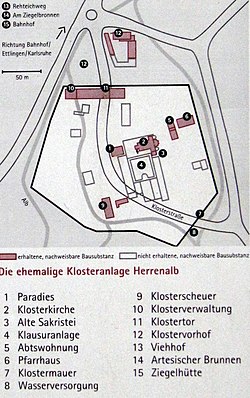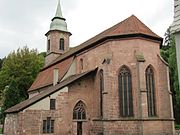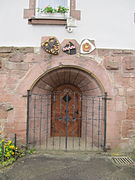Herrenalb Monastery
| Herrenalb monastery complex | |
|---|---|

|
|
| location |
Germany Baden-Wuerttemberg |
| Coordinates: | 48 ° 47 '46.3 " N , 8 ° 26' 12.8" E |
| Serial number according to Janauschek |
228 |
| founding year | 1148 |
| Year of dissolution / annulment |
1536 |
| Mother monastery | Neubourg monastery |
| Primary Abbey | Morimond Monastery |
The monastery Herrenalb was a 1148 by Cistercian monks founded the monastery in the area of today's community of Bad Herrenalb in the district of Calw in Baden-Wuerttemberg .
history
Around 1149, Count Berthold III founded from Eberstein Herrenalb. He donated Alba Dominorum out of gratitude that he was allowed to return home from the Second Crusade . He handed the monastery over to the Cistercians. They came with their abbot from the mother monastery in Neuburg / Hagenau in Alsace. The founding deed is only available in a copy from 1270.
The order of the Cistercians owes its importance to Bernhard von Clairvaux . As abbot of the third daughter abbey of Citeaux , he had a decisive influence on him. Nothing should distract the brothers from focusing on God. In contrast to the powerful monastic empire of Cluny , they wanted to lead the original Benedictine life again. This was determined by strict adherence to the precisely defined rhythm of worship, prayer and working hours. Her mystical veneration of the suffering Christ and the piety of Mary marked the order. The brothers lived in poverty and simplicity. The Cistercian monasteries lay in the greatest solitude. That protected from distraction.
Cistercian monasteries supplied themselves with what they needed. The monastery mill and the bakery processed the grain of the fields. Artificially created ponds supplied the brothers with fish. In the monastery garden the monks grew vegetables, fruit trees and herbs. Beehives supplied the inhabitants with honey. Vines were planted where the location factors allowed it.
The achievements resulting from the way of life turned the Cistercian monasteries into economic and cultural centers at the end of the 13th century. In Herrenalb, the original equipment with real estate increased through acquisitions and donations. In 1450 37 villages belonged to the monastery and in 127 localities it achieved income from rights and goods. The monastery owned goods in the Alb valley as well as in the communities of Ottersweier , Malsch (acquired in 1318), Bruchsal , Oberderdingen , Vaihingen an der Enz and Merklingen (1296).
From 1289 the monastery came under the influence of the Margraves of Baden and from 1338 under the patronage of the Counts of Württemberg . It was devastated in the Peasants' War in 1525. After Duke Ulrich introduced the Reformation in Württemberg in 1534, the monks had to leave the monastery temporarily in 1536. As in the 12 other large male monasteries in Württemberg, Duke Christoph von Württemberg set up a Protestant monastery school in the monastery in 1556, but it was closed again in 1595. After the severe damage by Swedish troops in the Thirty Years' War in 1642, the Cistercian monastery was finally dissolved in 1649.
Buildings and plant
Some buildings from the former monastery are still there today:
The monastery gate is located at the passage to the monastery area. It formed the gateway to the outside world.
There are also remains of the Romanesque vestibule. This paradise was built around 1200 and increased in the late Gothic 1,462th It was the meeting room of the conversations and served as a burial place.
Gallery Romanesque vestibule (paradise)
The three-aisled Romanesque basilica of the monastery was completed in 1177. The side choirs received tracery windows around 1330. Margrave Bernhard I of Baden set up a cenotaph near the main altar. In 1478 the main choir was redesigned.
The Gothic choir of the monastery church was converted into a Protestant church in 1739.
The sacristy is the only room left in the former enclosure. This was added to the church around 1200. Inside it has a ribbed vault and remains of paintings.
To the east of the church, opposite the sacristy , was the abbey building. The abbot did not originally live in his own apartment. It was not until the 13th century that there were abbot houses.
The monastery barn is one of the well-preserved farm buildings from around 1200.
Visible foundation masonry of the town hall belonged to a fortification corner tower of the walling. The year 1432 is recorded.
literature
- Peter Rückert, Hansmartin Schwarzmaier : 850 years of Herrenalb Monastery . Stuttgart 2001, ISBN 3-7995-7819-6 .
- Manfred Kohler: The buildings and equipment of the former Cistercian monastery in Herrenalb . Heidelberg 1994.
- Carl Seilacher: A Cistercian monastery that has disappeared . Karlsruhe 1927.
Web links
- Herrenalb Cistercian Abbey in the database of monasteries in Baden-Württemberg of the Baden-Württemberg State Archives
- Former Cistercian abbey "Alba Dorum" on the website of the evangelical parish Bad Herrenalb
Individual evidence
- ↑ Latinized name of the Herrenalb Monastery: Monasterium Albanum.
- ↑ a b c Information board: Historical route Herrenalb Monastery, The Cistercian Herrenalb Monastery and its history
- ^ Text of the founding document, in: Wirtembergisches Urkundenbuch . Volume II, No. 330. Stuttgart 1858, pp. 49–51 ( digitized , online edition )
- ↑ a b c RPZ Heilsbronn (ed.): The monastery as a lived form of faith . Shown using the example of the former Cistercian Abbey of Heilsbronn. Freimund printing site = Neuendettelsau, 1995.
- ↑ Historischer Weg Kloster Herrenalb, 1 Paradies
- ↑ Historical route Herrenalb monastery, 2 monastery churches
- ↑ Historischer Weg Kloster Herrenalb, 3 old sacristy, 4 cloister complex
- ↑ Historischer Weg Kloster Herrenalb, 5 abbot's apartment
- ↑ St. Bernhard parish, Bad Herrenalb. The history of the Bad Herrenalb monastery. (No longer available online.) Archived from the original on December 31, 2012 ; accessed on May 31, 2013 .
- ↑ Historischer Weg Kloster Herrenalb, 10 Klosterverwaltung















